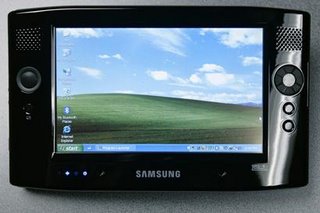Ultra-mobile Origami looks a winner
The first ultra-mobile tablet PC to use Microsoft’s new Origami technology was unveiled by Samsung at Cebit this morning.
 The Q1 UMPC (see picture) looks like it will be a winner, even without Origami. It will sell for less than 1,000 euros and weighs just 779gm with a 7in touch screen. It also has a 40GB hard drive, 512MB of Ram and Bluetooth 2.
The Q1 UMPC (see picture) looks like it will be a winner, even without Origami. It will sell for less than 1,000 euros and weighs just 779gm with a 7in touch screen. It also has a 40GB hard drive, 512MB of Ram and Bluetooth 2.
According to the specs it supports only 11b Wifi, not the faster 11g, and it uses a low-drain low-voltage Celeron processor.
Like many of Samsung’s products it supports Digital Media Broadcasting, the multimedia version of the DAB signal used for digital radio in the UK.
A picture in the Cebit newsletter shows Origami on the machine, with a virtual keyboard split into arcs on the lower right and left of the screen.
Meanwhile, at the Intel Developer Forum, which is also taking place this week in San Francisco, Intel executives showed off ultra mobile PCs in their keynotes.
Sean Maloney, executive vice president and general manager of the mobility group at Intel, said: 'There's a huge effort to shrink the PC architecture.'
He showed several designs, and said they would be available from a number of companies over the coming months.
 The Q1 UMPC (see picture) looks like it will be a winner, even without Origami. It will sell for less than 1,000 euros and weighs just 779gm with a 7in touch screen. It also has a 40GB hard drive, 512MB of Ram and Bluetooth 2.
The Q1 UMPC (see picture) looks like it will be a winner, even without Origami. It will sell for less than 1,000 euros and weighs just 779gm with a 7in touch screen. It also has a 40GB hard drive, 512MB of Ram and Bluetooth 2.According to the specs it supports only 11b Wifi, not the faster 11g, and it uses a low-drain low-voltage Celeron processor.
Like many of Samsung’s products it supports Digital Media Broadcasting, the multimedia version of the DAB signal used for digital radio in the UK.
A picture in the Cebit newsletter shows Origami on the machine, with a virtual keyboard split into arcs on the lower right and left of the screen.
Meanwhile, at the Intel Developer Forum, which is also taking place this week in San Francisco, Intel executives showed off ultra mobile PCs in their keynotes.
Sean Maloney, executive vice president and general manager of the mobility group at Intel, said: 'There's a huge effort to shrink the PC architecture.'
He showed several designs, and said they would be available from a number of companies over the coming months.

0 Comments:
Post a Comment
<< Home